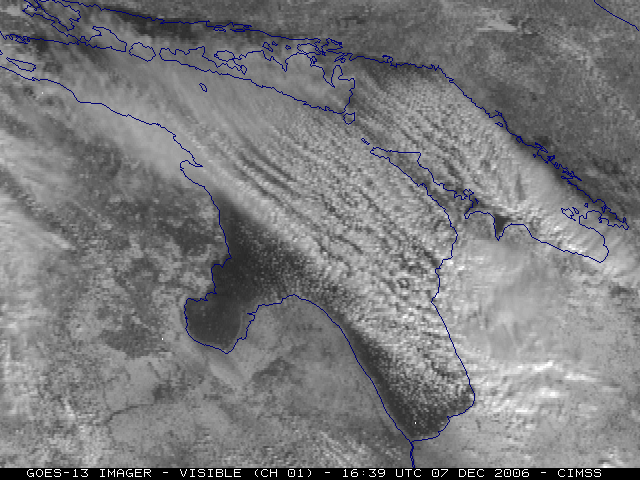
[ Archive ]

 |
CIMSS-NOAA Weekly Report
[ Archive ] |
 |
IN THE PRESS:
ITEMS FOR THE ADMINISTRATOR:
ITEMS FOR THE ASSISTANT ADMINISTRATOR
ITEMS FOR THE OFFICE DIRECTOR, STAR
GOFC/GOLD Fire Workshop at EUMETSAT: On December 4-6, E. Prins co-chaired the Global Observation of Forest and Land Cover Dynamics (GOFC/GOLD) 2nd Workshop on Global Geostationary Fire Monitoring and Applications at the EUropean Organization for the exploitation of METeorological SATellites (EUMETSAT) in Darmstadt, Germany. Over 45 representatives from 18 different countries in Europe, Africa, Asia and the Americas participated in the workshop. The primary goals of the workshop were to assess progress made since the last workshop and discuss ongoing activities and plans for the development, implementation, validation and application of regional and global geostationary fire products. The number of countries and research groups involved in geostationary fire monitoring has significantly grown in the last 2 years with applications in a variety of areas (hazards, air quality monitoring, climate change, and industrial applications). The Geostationary Operational Environmental Satellite (GOES) Biomass Burning Monitoring Team at the Cooperative Institute for Meteorological Satellite Studies (CIMSS) gave four presentations at the workshop. (E. Prins, E/RA2, 530-271-2256, C. Schmidt, CIMSS, 608-262-7973, J. Hoffman, CIMSS)
40th Anniversary of Geostationary Satellites: The Space Science and Engineering Center (SSEC)/Cooperative Institute for Meteorological Satellite Studies (CIMSS) celebrated the 40th Anniversary of the launch of ATS-1, the first U.S. geostationary weather satellite, on December 6. An afternoon symposium was hosted by SSEC Director Hank Revercomb and included presentations by Paul Menzel, NESDIS Chief Scientist, and Steve Ackerman, CIMSS Director. A reception followed where the achievements of SSEC and CIMSS founder Verner Suomi were discussed. Suomi, known as the Father of Satellite Meteorology, led the team that put the first weather experiment into earth orbit in 1958 and developed the concept of the spin scan camera for geostationary orbit so "the clouds moved and not the earth". (T. Achtor, CIMSS, 608-263-4206)
First Day of GOES-13 Science Test - Observing Lake Effect Snow:
With data from the first day (December 7, 2006) of the Geostationary
Operational Environmental Satellite (GOES)-13 National Oceanic and
Atmospheric Administration (NOAA) Science Test, nearly continuous 5-min
animations of Lake Effect Snow (LES) were observed. The imager was
placed into Rapid Scan Operations mode, to monitor the development of
lake-effect snow (LES) bands across the Great Lakes region. Extensive
LES bands were noted over Lake Huron and Georgian Bay. More information
can be found at: http://cimss.ssec.wisc.edu/goes/blog/2006/12/07/goes-13-first-day-of-post-launch-science-test/ or http://rammb.cira.colostate.edu/projects/goes%5Fn/.
5-min imager data emulates the expected coverage rate of Continental
U.S. (CONUS) with Advanced Baseline Imager (ABI) data from GOES-R. (S.
Bachmeier, CIMSS, 608-263-3958, G.S. Wade, E/RA2,
608-263-4743, gary.s.wade@noaa.gov, T. Schmit, E/RA2,
608-263-0291, tim.j.schmit@noaa.gov).
 (Click image to enlarge)
(Click image to enlarge)
Caption:
This GOES-13 Imager visible band animation shows extensive Lake Effect
Snow (LES) bands moving inland over southeastern Ontario during the
day. These data were supplied by the Space Science and Engineering
Center (SSEC) Data Center.
ITEMS FOR THE DIVISION CHIEF, CoRP
THORPEX 2nd International Science Symposium: Cooperative Institute for Meteorological Satellite Studies (CIMSS) scientists Chris Velden, Howard Berger and Ralph Petersen attended the 2nd Thorpex Science Symposium held in Munich, Germany. The symposium focussed on key areas in meteorological data assimilation, observing systems, dynamical process studies, societal impacts, and upcoming field campaigns. Velden chaired the session on Observing Systems which included a keynote presentation by Lars Peter Riishjgaard from the Joint Center for Satellite Data Assimilation (JCSDA). Posters by Berger, Petersen and Velden were presented on satellite data optimization, validation and assimilation efforts. (C. Velden, CIMSS, 608-262-9168, H. Berger, CIMSS, R. Petersen, CIMSS)Other Meetings and Telecons:
None.
VISITORS:
NEXT WEEK:
LOOKING AHEAD: